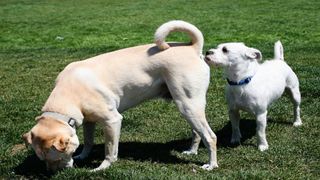
Dogs can get all kinds of information from sniffing another canine’s derriere.
(Image credit: Lily Chou/Getty Images)
When two dogs meet, they often go straight for a whiff of each other’s behind. And anyone living in a multicat household will tell you that cats regularly put their nose under their fellow felines’ tails.
So why do dogs sniff each other’s butts? It turns out, there’s a good reason behind this bottom-sniffing obsession.
“Dogs can tell [another dog’s] health and reproductive status, identify what they have eaten, and generally catch up on the ‘news’ from smelling each other’s rear ends,” said Ellen Furlong, an associate professor of psychology who specializes in animal cognition at Transylvania University in Lexington, Kentucky.
Mating also plays a role. “Male (particularly unaltered) dogs may also spend more time sniffing females for information about their reproductive status,” Furlong told Live Science in an email.
But how is it possible for dogs to glean all of this information from a simple butt sniff? One of the first clues for unraveling this mystery came in 1976, when a study on dogs and coyotes was published. The study found that two small pouches, one on each side of a dog’s anus — known as anal sacs — release a cocktail of smelly chemicals, including fishy-smelling trimethylamine and pungent propionic acid and butyric acid. These anal sac secretions probably serve as chemical communication signals between dogs, according to a study published in 2021.
Related: Why do cats’ claws retract but dogs’ claws don’t?
Each chemical released by a dog is likely to relay specific information to another dog, but scientists have yet to crack this scent code. A study published in 2023 made some headway in decoding this chemical language by comparing the anal sac secretions of male and female dogs. It found that certain chemicals were released only by females and others only by males.
Get the world’s most fascinating discoveries delivered straight to your inbox.
The researchers also recorded a lot of variation in the chemicals released and their concentrations among individuals of the same sex. This suggests that parameters besides gender influence a dog’s odor profile, the researchers said.
So a dog sniffs out a mixture of chemicals in another dog. Thanks to their far superior noses, dogs can identify individual smells in a mixture and detect them at significantly smaller concentrations than humans can. “A dog’s sense of smell is 10,000 to 100,000 times better than ours. Dogs can smell 1 part per TRILLION, which is truly astounding,” Furlong said.

Cats also have a habit of sniffing each others’ rear ends. (Image credit: Shutterstock)
Cats do it, too
A cat’s sense of smell also far exceeds a human’s. Research suggests that scent detection is central to cats’ behavior and overall cat welfare, Kristyn Vitale, an assistant professor of animal health and behavior at Unity Environmental University in Maine told Live Science in an email.
Like dogs, cats have small glands that produce chemicals with distinct odors. “From smelling another cat’s rear end, a cat can identify whether that individual is familiar or unfamiliar to them, as well as the cat’s sex and even possibly their reproductive status,” Vitale said.
“Both male and female cats utilize scent to identify social partners and communicate with them,” she added.
In 2023, researchers at the University of California, Davis, unveiled another piece of the bottom-sniffing puzzle through a study of 23 domestic cats. They found that a cat’s anal glands are home to a bustling community of bacteria, which are probably involved in the production of smelly anal gland secretions. Different cats had different bacteria in their anal glands, and the types of bacteria varied with a cat’s age and weight status.
More research is required, but the study authors believe that these bacteria help cats communicate. Other carnivores, including dogs, are also thought to communicate via the secretions of gland-inhabiting bacteria. Supporting this hypothesis, a study in hyenas found that bacteria living in their scent glands produce components of chemical signals that hyenas use to communicate.
Clarissa Brincat is a freelance writer specializing in health and medical research. After completing an MSc in chemistry, she realized she would rather write about science than do it. She learned how to edit scientific papers in a stint as a chemistry copyeditor, before moving on to a medical writer role at a healthcare company. Writing for doctors and experts has its rewards, but Clarissa wanted to communicate with a wider audience, which naturally led her to freelance health and science writing. Her work has also appeared in Medscape, HealthCentral and Medical News Today.
>>> Read full article>>>
Copyright for syndicated content belongs to the linked Source : Live Science – https://www.livescience.com/animals/dogs/why-do-dogs-sniff-each-others-butts

























![Forest ecology cannot be reduced to arithmetic, says M.I. Varghese [Interview] – Mongabay-India](https://earth-news.info/wp-content/uploads/2025/12/328946-forest-ecology-cannot-be-reduced-to-arithmetic-says-mi-varghese-interview-mongabay-india-120x86.jpg)





